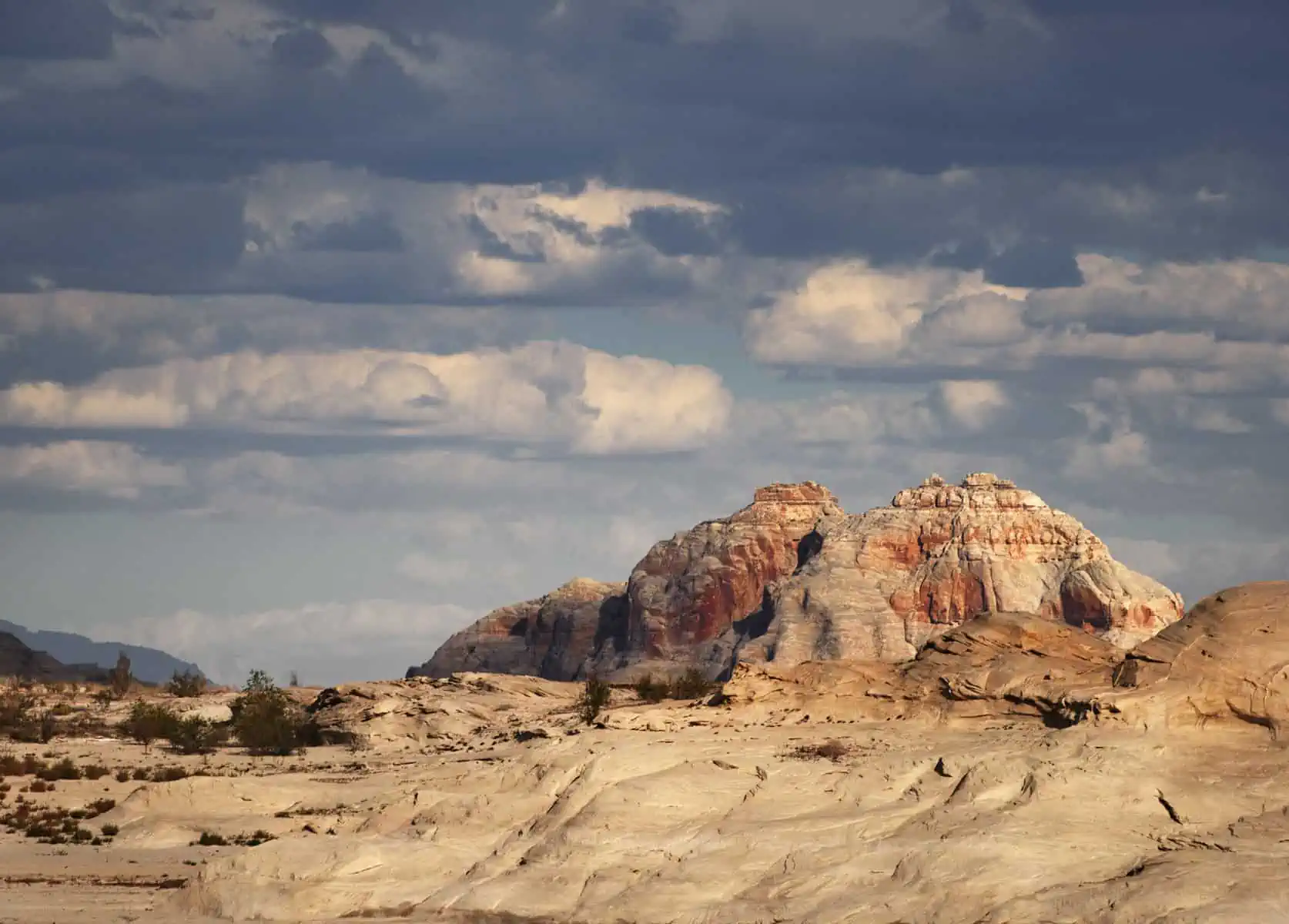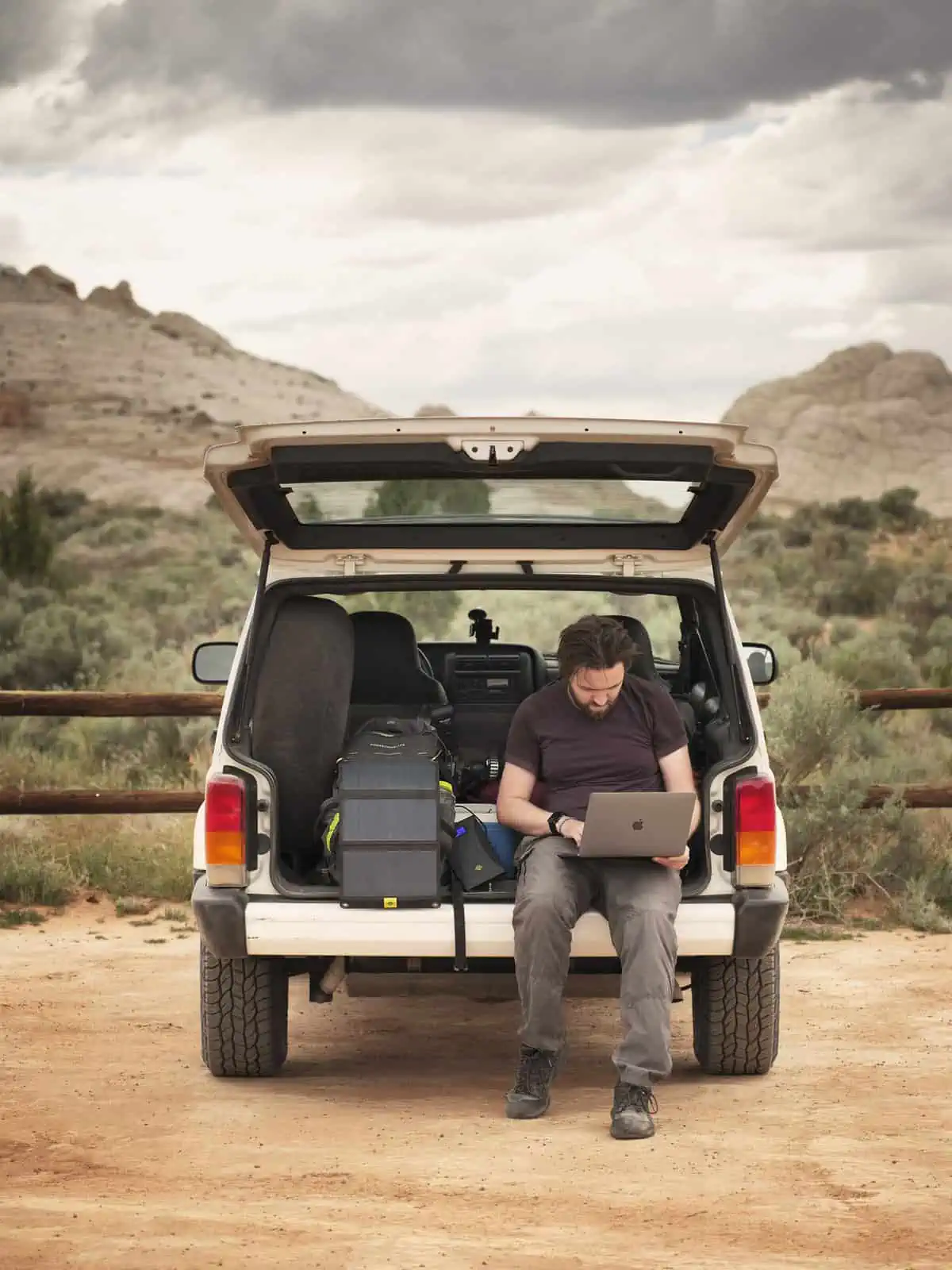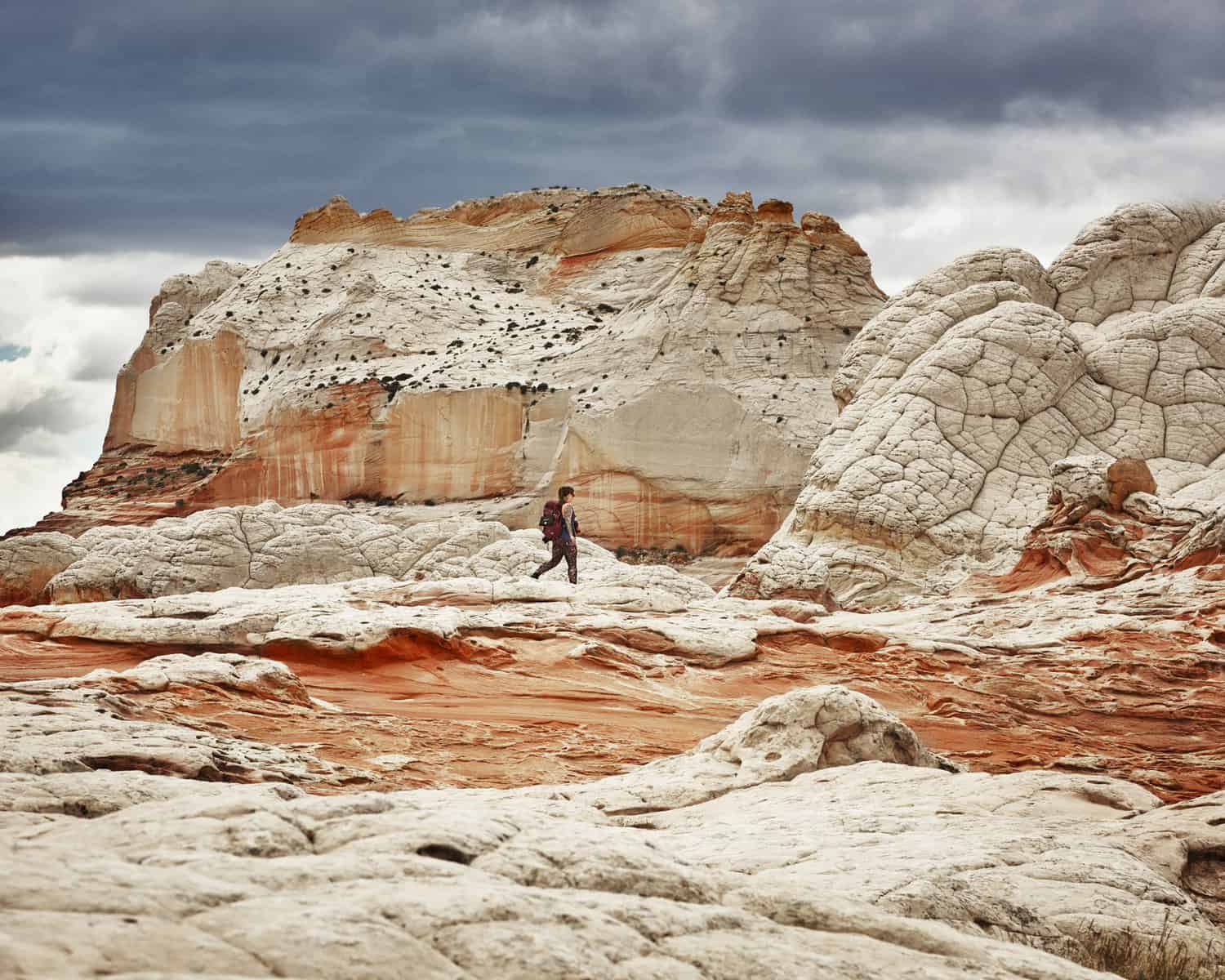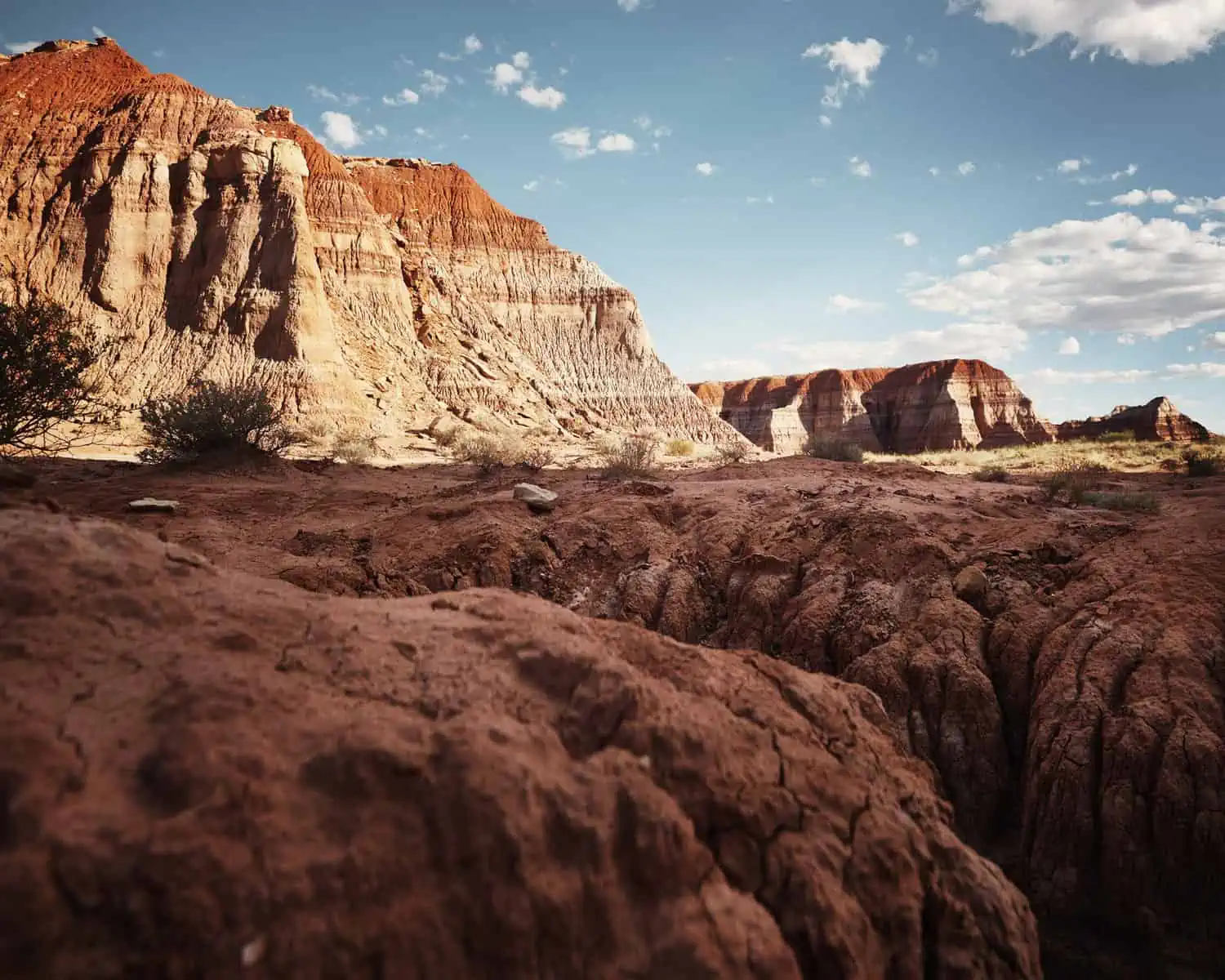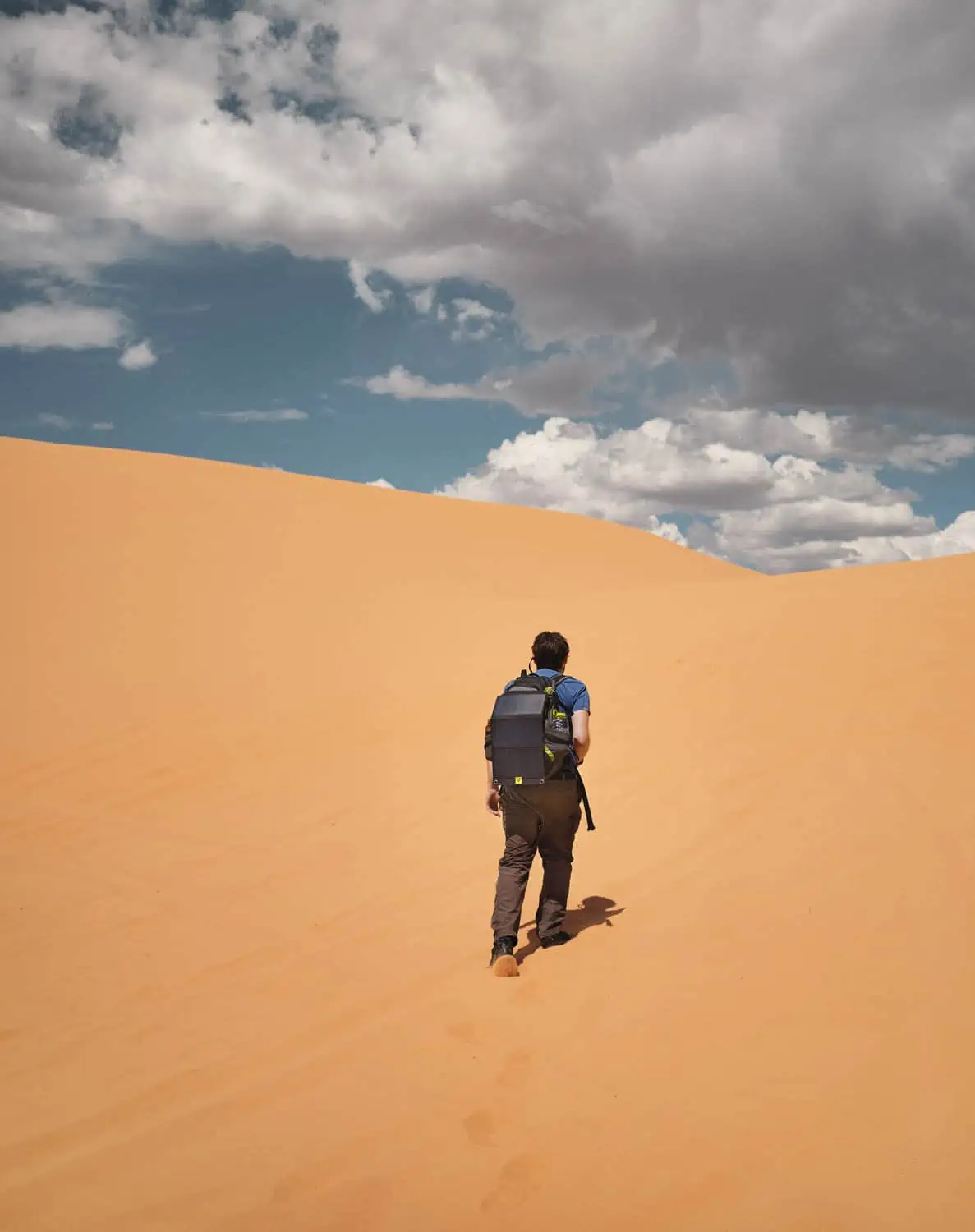This post is sponsored by PowerTraveller
The start of a new project always brings with it a mix of excitement and anticipation.Excitement because finally your prep and research can be put into action and you can move into the production stage. The anxiety is a little more complex: will the images live up to your hopes?Was our research enough?Will we hit any unexpected hurdles?
In May 2019 we found ourselves in Utah for the second time.Our first trip less than a year before had been intended as a chance to take in the National Parks in the Southern part of the State – Zion and Bryce – and also to head into Arizona to see the North Rim of the Grand Canyon.Undeniably, these were all spectacular, but something else came out of that visit too: the hosts of the Air BnB we were staying in knew the area like the back of their hand and suggested a number of other hikes and drives to us. Further evenings spent with them turned into plans to head out on All Terrain Vehicles (ATVs) and 4x4s to locations that our now friend kept telling us ‘you know, if you get lost out there, your done!’.
Long, hot days in the sun meant a wealth of renewable energy at our fingertips – its all about utilising the environment you’re going to be in and using it to the best of its advantage.
As we spent more time in the starts of these landscapes, we found ourselves falling passionately in love with what was around us. We became backcountry obsessed and marvelled at the solitude we experienced. What excited us the most was that if these untouched landscapes were just the start, where would we be able to go with more exploration and the knowledge of the area contained in our friend and guide’s brain?
It became clear that this would form the foundation of a large, ambitious project documenting public lands, but more specifically often unseen landscapes in the American West, some of which don’t even come up in Google searches or on a map.
Parts of Arizona formed an incredible backdrop for the project.
But there was a problem.Much of this natural splendour is overlooked for one good reason: it is not easily accessible.In many cases, the places we wanted to visit we’re miles off the main roads – too far to realistically hike, especially in the hot and dry desert environment – and the access roads that branch off the main roads often rapidly degenerate into dirt tracks, unsuitable for a regular car and requiring a high clearance 4×4 or a smaller ATV to make progress.So, we would need to factor this in with our choice of vehicle for the trip.
Some of the locations we intended to visit would require permits.These would need to be acquired in advance and tied us to certain days – so we wouldn’t have the luxury of postponing a visit to a location if the weather didn’t look right.
Mapping would also be an issue.Platforms like Google or Apple Maps are great for navigating on main roads, but once you get into the wilderness, you are often confronted with large areas of empty space and more specialised mapping is required.In Europe, we are spoiled with the amount of high detail, up to date maps available in most countries.Perhaps surprisingly, America is a different proposition.The USGS Topographic maps that appear to be the standard look to be based on old survey data (the fact that many of the labels are hand-written on the maps is also an indicator of their age).In Southern California, we’ve found several instances of the maps being inaccurate.Would these maps be sufficient to navigate the maze of trails we would encounter in Utah and Arizona?
The Falcon 21 and Power Gorilla allowing us to charge as we go.
One thing we could depend on in the open desert was good GPS reception, so, even if the maps were somewhat inaccurate, we could at least know our position, and this would allow us a good degree of confidence with navigation.It goes without saying here that having offline mapping available is essential – we knew there were slim chances of having any kind of phone reception.It would be vital for us to keep our GPS running whilst we were out shooting.
This leads on to the issue of safety.Many of the locations we planned to visit were well off the beaten track.Having started to shoot the project, we can say that there were several days when we basically had nature to ourselves, often going long periods at a time without seeing another person. This might sound wonderful, and it was, but this does, of course, come with a flip side.If you are on your own and something goes wrong, then you have to be able to fend for yourself.One of our main concerns was with the driving we would need to do.Whilst we didn’t plan to drive ‘off road’ per say, some of the access roads we needed to use are roads only in the loosest possible sense of the word – with large rocks and section of deep sand to navigate. There was plenty of scope for the vehicle to get stuck, and stories of people dying in the desert when this happens are not uncommon in Utah.
The final major concern would be that we intended to photograph this project using a new camera system. We would be using the Fujifilm GFX50S camera and, whilst this has been around for a few years, it was new to us. We didn’t have enough experience with the camera to know for sure what its battery life was like, and the last thing we wanted to spend a whole day travelling to a location only to arrive with no battery power left.We had four batteries for the camera, but on a full day of shooting and image review, would this be enough?
The incredible landscapes of Arizona and making plentiful use of the day – even though we did not have full sun, we still found that we were able to get a massive amount of power from the Falcon 21.
This was going to be a difficult project and would require more careful planning than most of our regular trips.As with all such planning, managing your resources is key. We are heading out into a desert, so we need to bring a lot of water.But how much exactly?And once you reach the trail head, how much of that water do you carry with you and how much do you leave in the car?We also reached the conclusion that battery power would be an important resource on this project.We would certainly be able to keep some devices charged from the cigarette lighter power outlet in our vehicle; splitting this between the ATV and the 4×4 but this would not be enough if we needed to be charging camera batteries and our GPS. It’s true that many vehicles – especially larger 4x4s or SUVs – now come with multiple power outlets and even mains style plug sockets, but as we would be renting, we could not be sure of this.Also, we anticipated spending long periods of time hiking in the desert. We would need some form of auxiliary battery power.
Powertraveller have been our brand of choice for power banks since we worked with their products in the Alps early in 2019.Having discussed our requirements for this project with them, they supplied us with a number of their products: two of their Power Gorilla power banks and, two of their Falcon 21 Solar Chargers.
Our favourite mode of transport for accessing some truly remote landscapes!
We’ve worked with the Power Gorilla for some time.It’s basically a high capacity power bank.The current model has 24000 mAh capacity which is enough to charge a smartphone several times over or our 13in Macbook Pro once with some capacity still to spare.It comes with a stack of adapters that let you power a whole host of devices from non-smart phones to laptops.
The Falcon 21 is a completely different proposition.To be absolutely clear, it is not a battery pack.It is a solar charger.It’s made up of four sections – three solar panels plus a Velcro-sealed pouch housing the power outputs – and you can fold it up when not in use.The idea is that you attach it to your backpack unfolded and, as you hike, it will charge your device.It’s worth mentioning that the Falcon 21 is rated with IPX4 water resistance.This means that whilst it’s not fully waterproof, you don’t need to worry if it starts to rain – though I would likely pack it away if caught in a really heavy downpour.
We ran some tests, and the first results were impressive.For our location, we chose the Coral Pink Sand Dunes State Park in Utah.We had clear blue skies with occasional banks of cloud overhead, sometimes blocking the sun.We attached the Falcon 21s folded to our backpacks using the supplied carabiners.When we reached the trailhead for our hike, we undid the Velcro and unfolded the panels, leaving them hanging down over the height of our packs.The top section, housing the outputs, also serves as a Velcro sealed pouch large enough for a Smartphone, a camera battery charger or a smaller power bank like the Powertraveller Sport 25.Unfortunately, it is a little too small to hold the Power gorilla.Our first test was to see how the Falcon would do charging a smartphone – in this case an iPhone 8.The phone, with 75% battery, was plugged in and sealed into the top pouch.We hiked for just under an hour before I checked on it – I was fully expecting it not be charged, but the phone was already up to 100%.
As mentioned above, the pouch at the top of the Falcon 21 is too small to hold the Power Gorilla, but an easy solution is to run a long DC cable – supplied with the Power Gorilla – from the Falcon’s DC output to the Gorilla’s input and simply stow the Power Gorilla in your pack.And this became our preferred method of working.We used the Power Gorillas to keep our devices charged and, when they were not charging, we’d keep them topped up by connecting them to the Falcons.
We could see a lot of potential to adapt this setup to different scenarios.The Falcon panels could easily be set up on the roof of a car or camper van or hung from a tent in a camping scenario, and two Falcon 21’s could, during the course of a sunny day, fully charge two Power Gorillas which in turn could keep your devices charged and running through the night.
It all seems straight forward enough, but the reality was a little more complex.In order for this to succeed, we needed to make sure that parts from a variety of manufacturers would work together and you can’t assume that they just will!Discovering an incompatibility or realising you’ve forgotten a critical connecting cable when you’re in the middle of a hike, or camping miles from anywhere with your GPS on single digit battery power is very far from ideal – in fact it could well put you into a dangerous situation, so testing and forward planning is essential.
We were blown away by the landscape that surrounded us in Southern Utah.
The phone charging test with the Falcon 21 was one such part of our tests and was necessary to prove to ourselves that the solar charger could be relied on to charge a relatively high powered device, but most of the testing was done in the evening with the various parts we would be using laid out on the floor.
One problem we hit on very soon was with the batteries to the Fujifilm GFX50S camera we were using.Fujifilm’s own charger only comes with a mains plug, so straight away we would need to find another solution.It might have been possible to charge the batteries in the camera body, but this was not a great solution as it meant we’d need to tether the camera with a long cable so we didn’t look into this.The solution was to purchase a third party charger – in our case the Nitecore FX2 Pro.The key feature of this charger for us is that it has a Micro USB input so we can charge the batteries from either the Power Gorilla or directly from the Falcon 21, but it also offered a few other useful features, such as being able to charge two batteries at once and having a fairly comprehensive LCD.
Testing was key.We have written extensively before about the importance of planning and prep, but they key point here is that you do not want to be trying out equipment of the first time in the context of a live shoot. This doesn’t just apply to photography, this applies to anything from multiday camping to full on expeditions where you’ll be completely reliant on the devices you take with you.So, we tried out every power combination we were likely to need to use.We stripped back the accessories supplied with the Power Gorilla so we had just what we needed for this particular trip – this meant that we were not carrying extra cables and plugs, which not only take extra space and weight, but also serve to confuse matters when you are fumbling around looking for a particular cable.Where possible, we packed all of the power accessories together, so if we realised we needed to charge a camera battery, we could get it charging as quickly as possible and with the minimum interruption to our hike or shooting time.
When you’re planning a big trip, be it a multi day hike, a photo project, a content creation trip or press trip gaining confidence in your equipment is incredibly important. The tools you use should provide you with an enablement, and when you’re needing to concentrate, you don’t want to be thinking about and worrying over if everything you have, works. We had put a lot of time, effort and funding into making this trip happen so, whilst it wasn’t a once in a lifetime chance for us, we still needed to know that we could come back with the images we wanted.There is nothing worse than seeing an amazing scene and not being able to photograph it because your camera battery is dead or because your memory card is full (I’d say this is even worse than not having a camera with you in this situation – at least then you can console yourself with the thought that you made a conscious decision not to bring a camera!).
Depending on what you are planning on doing and the environment you are planning on doing it in, new challenges might present themselves, but so too may new solutions.It can certainly be daunting to try to bring all the pieces together that are necessary to make an involved trip a success – especially when you want to add photography into the mix too, but by breaking things down, assessing the issues and testing that your solutions work, you can make a success of the most complex projects.Aside from the satisfaction of returning home knowing that you have made some fantastic images and incredible experiences, there is a great deal of satisfaction that comes from knowing that your planning and research are the reasons for this success!
Our top preparation tips for taking action:
1.Get to know your gear.The more familiar you are with things like real-world battery performance and how things like extreme cold can affect it, then you are well set up for the next step…
2.Identify any potential problems.Let’s say you know a battery will last a full day of shooting and you have two batteries, but you will be hiking for three days, then you have identified an issue.Logistically, this is similar to working out how much food and water you need to bring.
3.Test your solutions.Just because your camera can be charged over USB doesn’t always mean it’s a practical solution.Charging this way might be unreasonably slow.So, test it all out before the trip! You don’t want to be discovering problems half way up a mountain!
4.Ensure you have everything you need to implement your solution with you.Make a packing list and double check that you have every accessory you need to make your solution work.Basically, this means checking you have the correct cables with you.On a recent hike, I knew I’d need to keep my phone charged for mapping purposes.I brought a battery pack, but in haste grabbed a Micro USB rather than Lightning Cable. So, I couldn’t keep my phone charged.In the end, my battery didn’t run out – but it got a bit too close for comfort!
5.Remember, you can’t anticipate everything! Nature loves to throw a curve ball and there will always be some unanticipated factor that complicates things.However, if you can most other things under control, then you can often take the unexpected in your stride.


